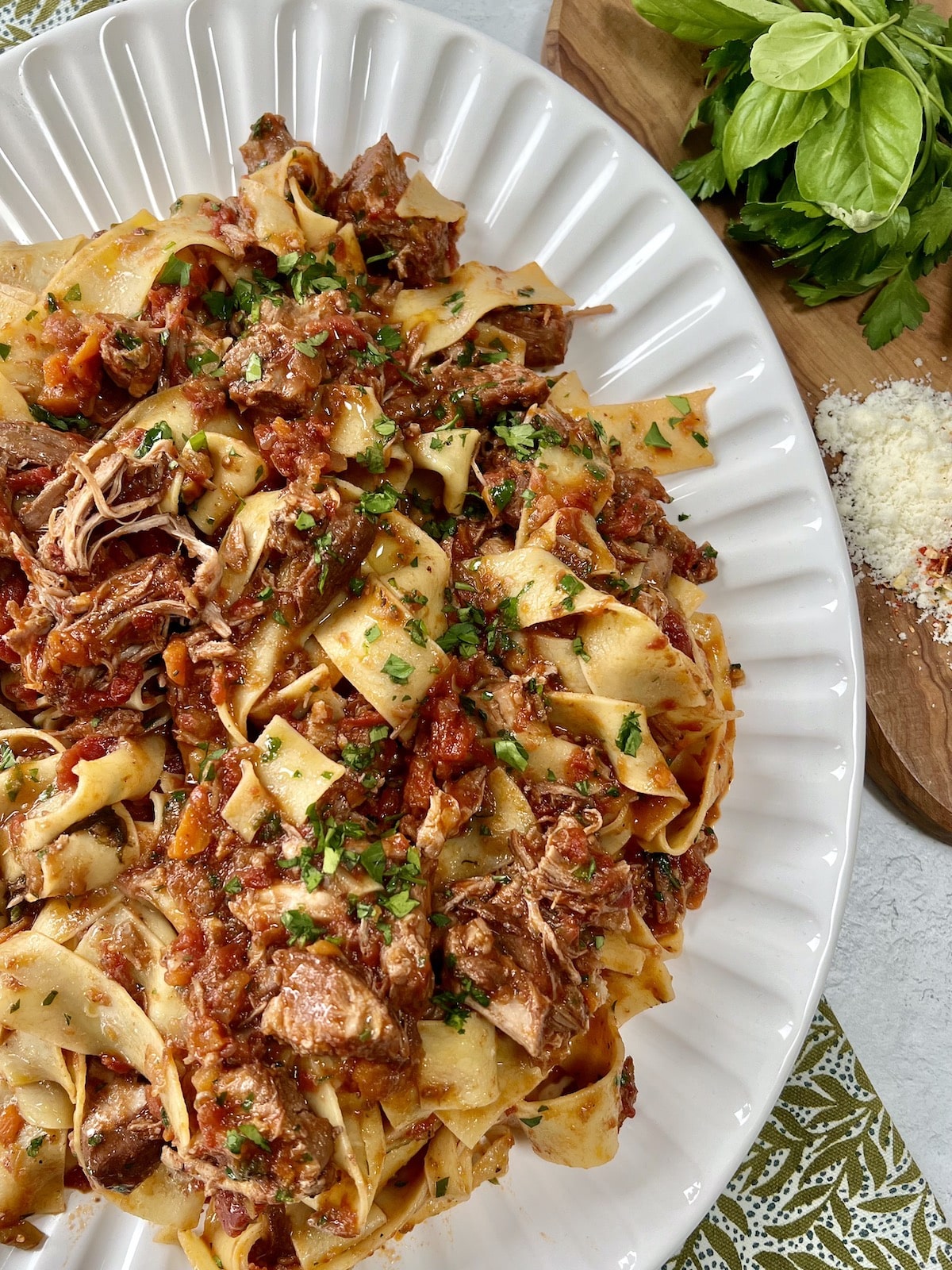
This post may contain affiliate links or sponsored content. That means if you click on my link and buy something, I will earn a small commission from the advertiser at no additional cost to you. For more information on this, please click here.
This Pork Ragu Recipe is the ultimate in Italian comfort food–hearty, warming and full of big flavors and aromas! Meaty, pork country-style ribs are slowly simmered in a rich red wine and tomato sauce with lots of aromatics until they’re fall-apart tender, then shredded and tossed with your favorite pasta.
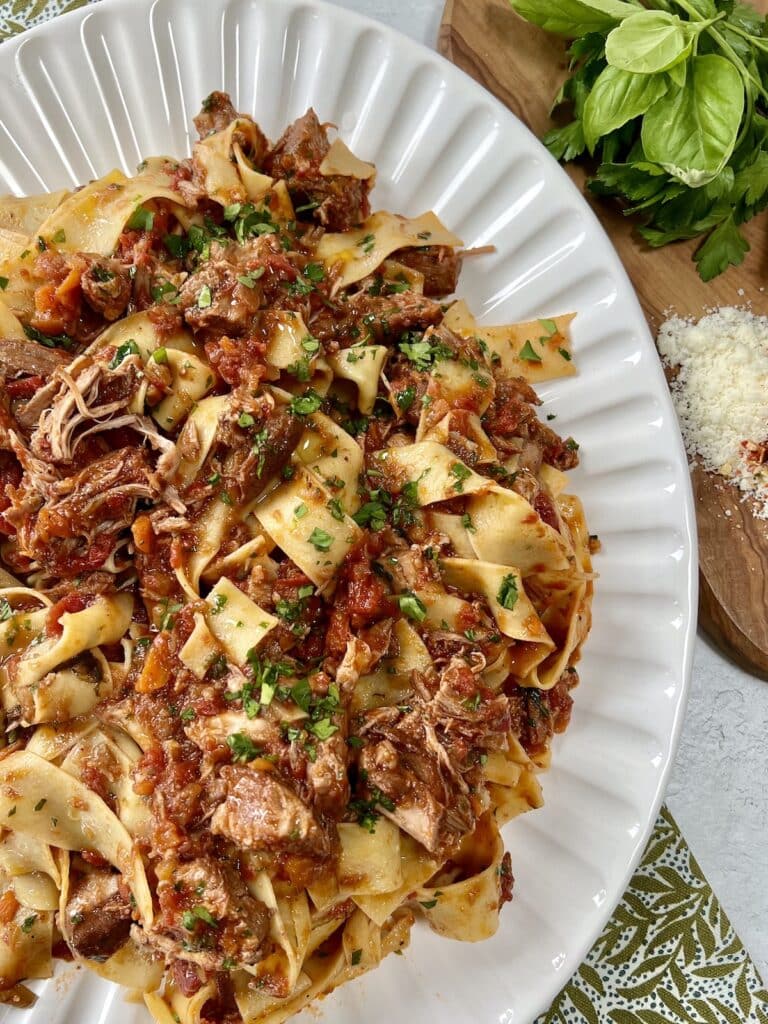
My mom often cooked meaty pork ribs in Sunday sauce and served them on the side to a big bowlful of pasta. She’d keep them on the bone, but the meat would fall off the second you picked up a piece to bring it over to your dish. I can still smell and taste them today!
This ragu recipe takes my mom’s ribs one step further. I shred the fork-tender pork meat, then add it back to the tomato wine sauce, creating a succulent and chunky pork rib ragu that is like no other! Topped off with some pecorino cheese and a spirited slug of extra virgin olive oil and all is right in the world.
If you like hearty, braised dishes like this one, also check out Italian Pulled Pork, Slow-Cooked Beef Brisket Ragu and Wild Boar Bolognese.
What exactly is a ragu and is it the same as Bolognese?
A ragù is a hearty, Italian meat sauce, typically served with pasta. Generally, tougher cuts of meat are browned, immersed in a braising liquid (tomato and/or wine-based) and then cooked on a low heat over a long period of time. Once cooked, the meat is removed from the sauce and traditionally served in a separate course, while the sauce is served with pasta for the first part of the meal. Here, I have alternatively shredded the meat and combined it with the sauce.
Bolognese is actually a type of ragu that is typical of the Bologna area in central Italy. It’s classically made with ground beef and pork and/or veal, braised in wine and a bit of tomato, and finished with a bit of milk.
What are Pork Country-Style Ribs?
Just like pork butt is not actually from the butt (it’s from the pig’s shoulder), pork country-style ribs aren’t really ribs at all! The name is a bit misleading as this cut actually comes from the shoulder area–specifically from the fatty, muscular section of the shoulder blade near the loin–and are also referred to as shoulder chops or blade steaks. County ribs are meatier than other cuts of ribs and are less likely to dry out during cooking–making them perfect for slow-cooking and braising. The marbling in the meat means these ribs become deeply flavorful once simmered in all those wonderful sauce flavors and aromas!
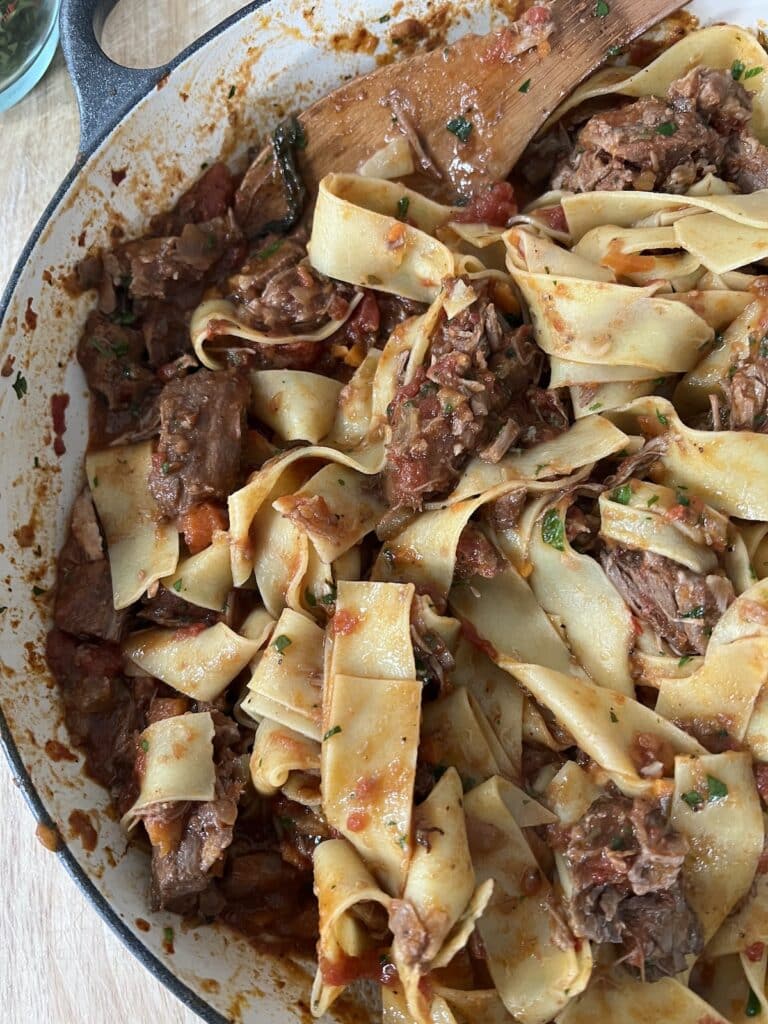
Why You Will Love This Recipe
- It Warms Your Soul. Seriously, though. This is the kind of food pasta dreams were made of.
- Make it in Advance: This sauce is easy to store, so you can make it ahead of time, keep it in the fridge, and heat it up and serve it when you’re ready to eat.
- Foolproof recipe! As long as you have some patience and time, you will be able to execute this dish perfectly. No advanced cooking skills necessary! Plus, it can be made on the stove, in the oven or in a slow-cooker.
- Built-In Leftovers! The sauce recipe makes enough sauce to dress 2 to 3 pounds of pasta. If you’re only making one pound pasta, freeze the remaining ragu in an airtight container for up to three months. This way, you can have a delicious pork ragu when desired any night of the week!
I love that that this pork rib ragu is slowly-simmered, rich, hearty and perfect for a large Sunday dinner on a cold winter night with pasta, bold red wine, a simple green salad and rustic Italian bread. Hope you give it a try, enjoy its aromas and flavor, and love it as much as I do!
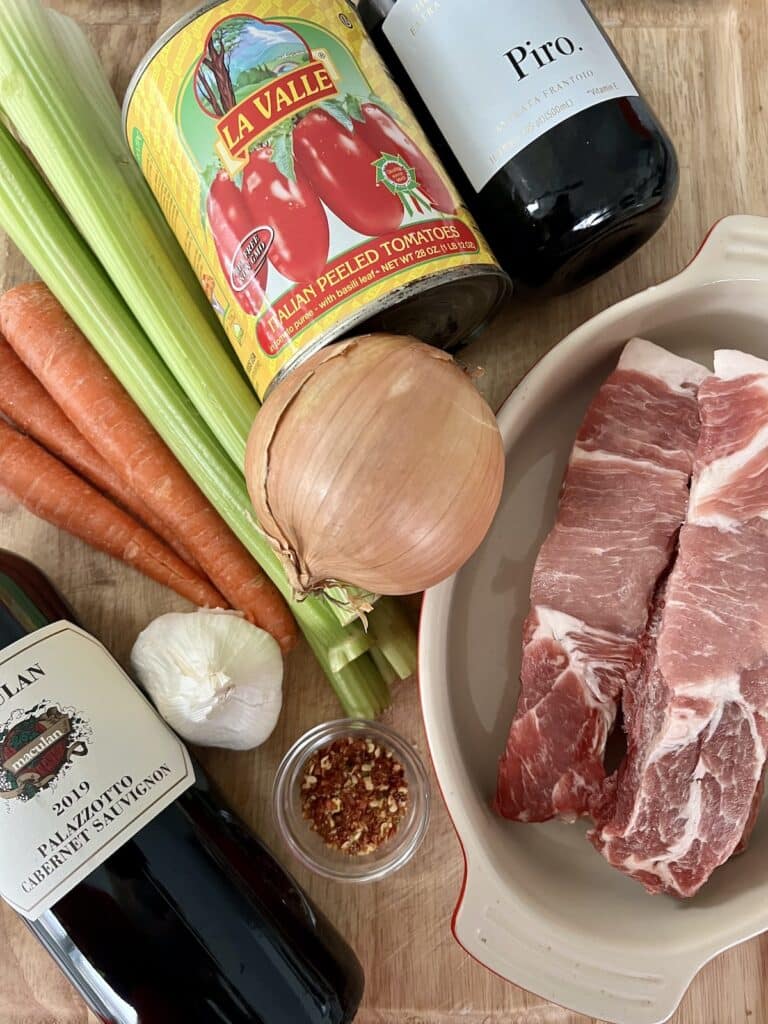
Ingredients for Pork Ragu Recipe
Here are the ingredients we’ll need for this pork ragu sauce:
- Pork: I use meaty and juicy, bone-in, pork country-style ribs in this ragu for their incredible flavor and texture. The bones contain collagen which simmers into the sauce, adding flavor, texture and protein. And, the braising technique breaks down the pork into a perfect, shred-able texture that clings beautifully to the wide pappardelle noodles. You can substitute half of the ribs with boneless pork shoulder if you would like.
- Onions, Carrots, Onions, Garlic, Fresh and Dried Herbs: These aromatics are all important flavor builders that complement and enhance the flavors of the other ingredients. Fresh herbs are also tossed with the final pasta for a bright, herby finish. While I do not use them in this recipe, some people like to add fresh sage leaves and bay leaves to the braising liquid–they are great additions!
- Red Wine: Choose a dry red wine for this recipe, such as a cabernet sauvignon, pinot noir, chianti or merlot. The wine adds depth and complexity, brings a layer of acidity to the dish, rounds out the overall flavor of the sauce and creates a beautiful aroma to boot! If you prefer to not use alcohol, though, you can use beef (preferred) or chicken broth or stock.
- Tomatoes: The base for this hearty sauce.
- Pasta: I used chunky pappardelle pasta here, my favorite with this sauce as it folds and envelops the ragu, so you get a bit of everything with each mouthful. But, this recipe works well with all sorts of strong pasta shapes that can hold up to it, such as rigatoni, gnocchi, ziti, penne rigate and paccheri.
- Extra Virgin Olive Oil: Adds some final richness to the finished pasta. Use a high quality oil for this finishing step.
- Butter (optional): Add a small amount to the finished pasta for increased richness and silkiness, restaurant-style.
- Pecorino Romano Cheese: The incredible sharpness and savoriness of Pecorino Romano cheese is just what the sauce needs to round out its flavors. But, Parmigiano-Reggiano would be just as delicious here!
A complete and detailed list of ingredients with amounts and instructions is included in the recipe below.

Pork Ragu Recipe, Step-by-Step (Pro-Tips Included!)
Here are the main steps for making this Italian slow cooked pork ragu:
- Gather and prep all ingredients. Separate the ribs into individual pieces if not already, and then pat them dry with a paper towel. Sprinkle all sides of the ribs with salt and black pepper.
- Heat oil in a or heavy-bottomed pot or large Dutch oven over medium heat. Carefully add as many ribs as will fit on the surface of the pot and sear them on multiple sides until brown, about 3 minutes per side. Remove the ribs to a plate once seared and set aside.
- PRO-TIP: Do this in batches and do not overcrowd the pot.
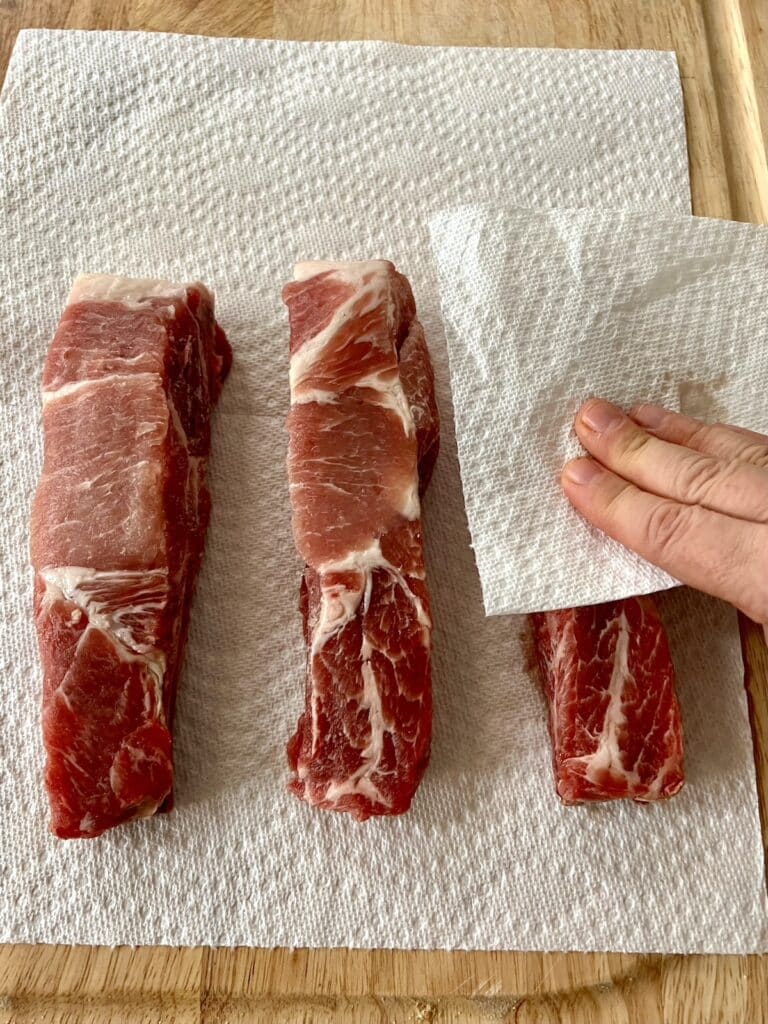

- Add the onions, carrots, celery, garlic, crushed red pepper and fresh basil and stir to coat with the fat. Reduce the heat to medium-low and cook until the vegetables have mostly softened, about 6 to 8 minutes, stirring occasionally.
- Pour the wine in and deglaze the pan, scraping up all the browned bits.
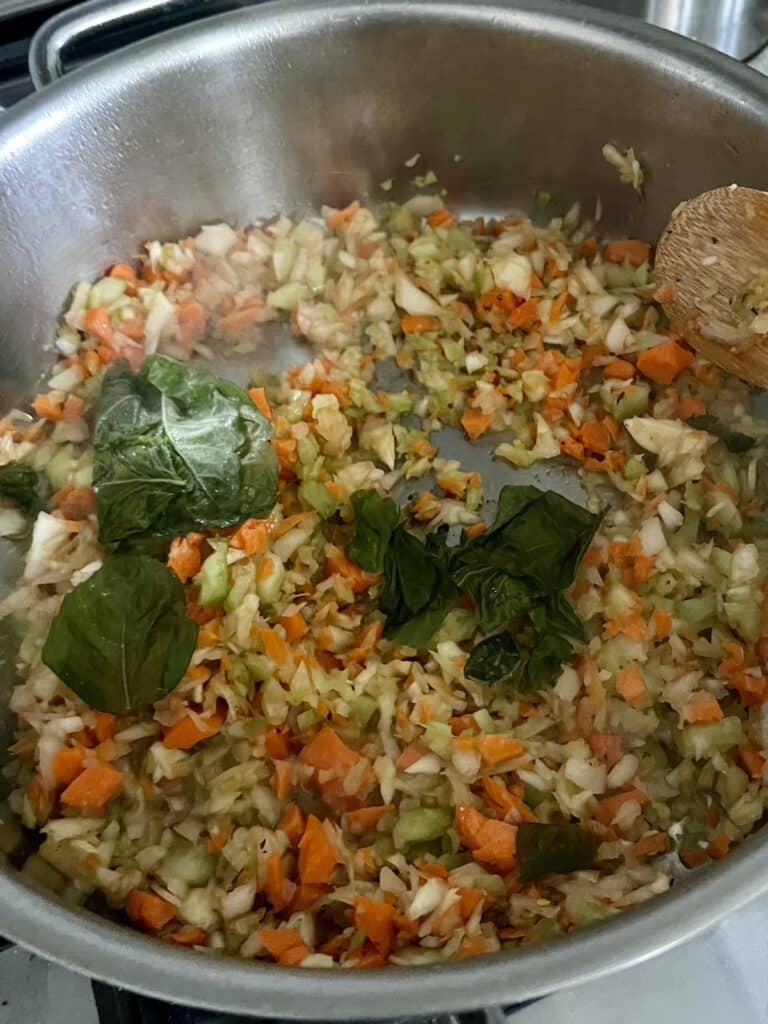
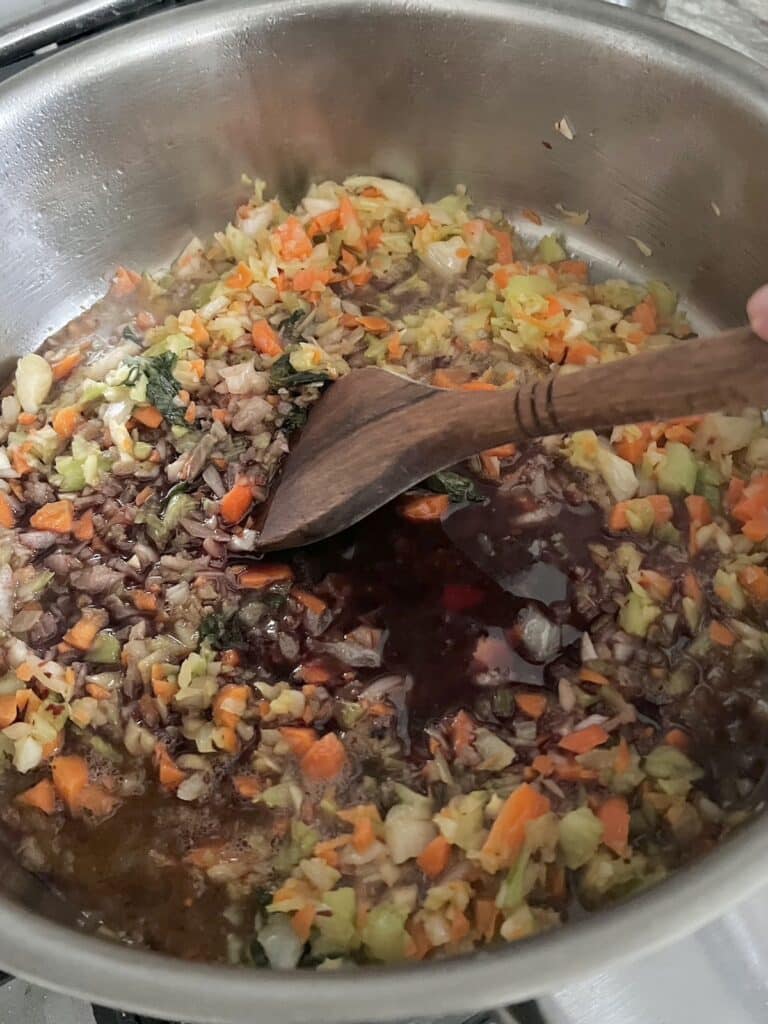
- Add the tomatoes, ½ can water, salt, dried oregano and ground black pepper and stir until all ingredients are well-combined.
- Carefully return the reserved ribs to the pot, along with any accumulated juices. Increase the heat to medium, cover and bring the mixture to a rolling simmer. Reduce the heat to maintain a low simmer and simmer, covered, for about 90 minutes. Then, change the lid to partially covered and continue cooking until the meat is fork tender and, literally, falling off the bone and a thick sauce has developed.
- PRO-TIP: This will take about 3 hours in total. Stir the mixture occasionally and test the texture of the pork every hour.
- PRO-TIP: Alternatively, cook the pork in a 300°F covered with foil.
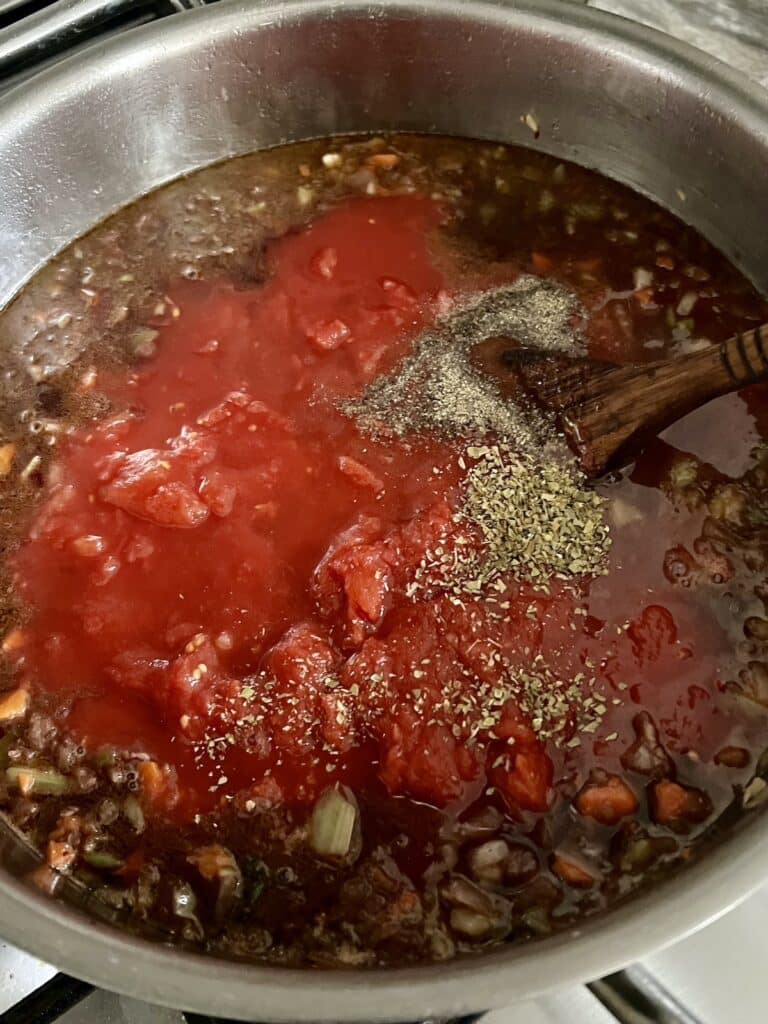

- Once the pork has reached the desired consistency, turn off the heat and transfer the ribs to a dish. Let them cool briefly.
- Then, remove the meat from the bones and discard all the bones. Shred the pork with two forks (or your fingers) and return the meat to the pot, combining it with the sauce.
- PRO-TIP: Or, if you prefer, keep the meat/ribs whole (with or without the bones) to serve on the side.

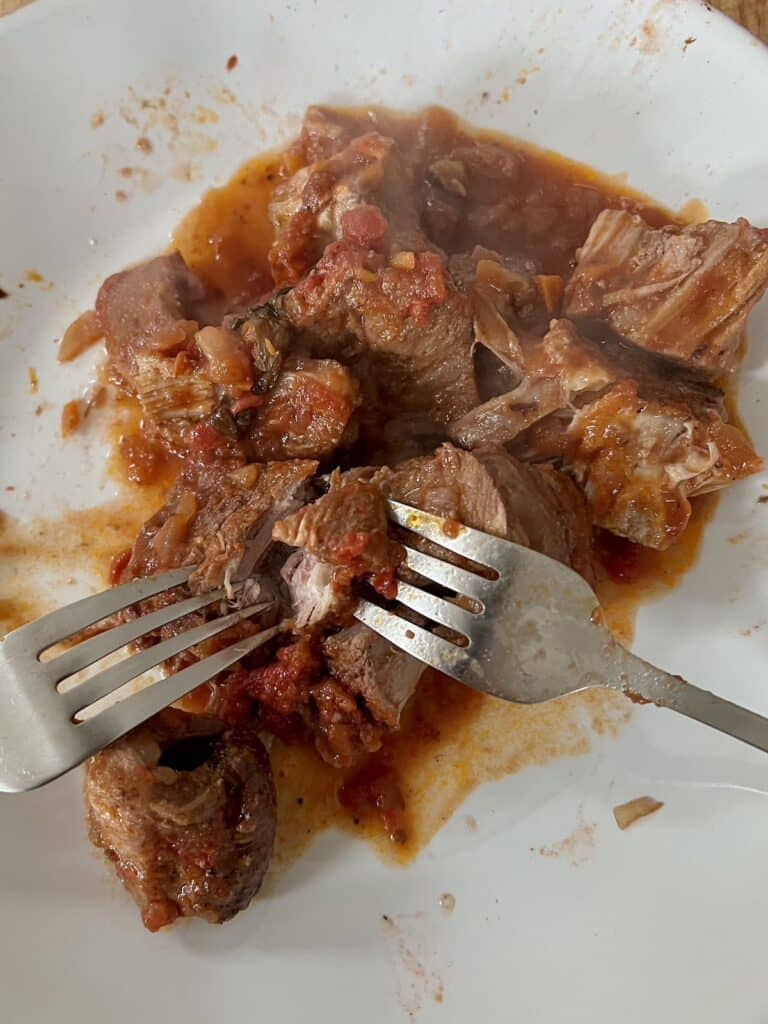
- Bring a large pot of water to a boil and transfer the ragu to a large skillet over medium-low heat.
- PRO-TIP: At this point, some people like to add a little heavy cream to make the sauce extra creamy and rich (and a bit like a ragu Bolognese). I don’t find it necessary, but go for it if you are feeling hearty!
- Add salt, then the pasta, to the boiling water, stirring frequently. Cook the pasta for 2 minutes less than the package directions, or about 2 minutes before you think it is al dente.
- PRO-TIP: Be sure to reserve at least 1 cup of the starchy pasta water.
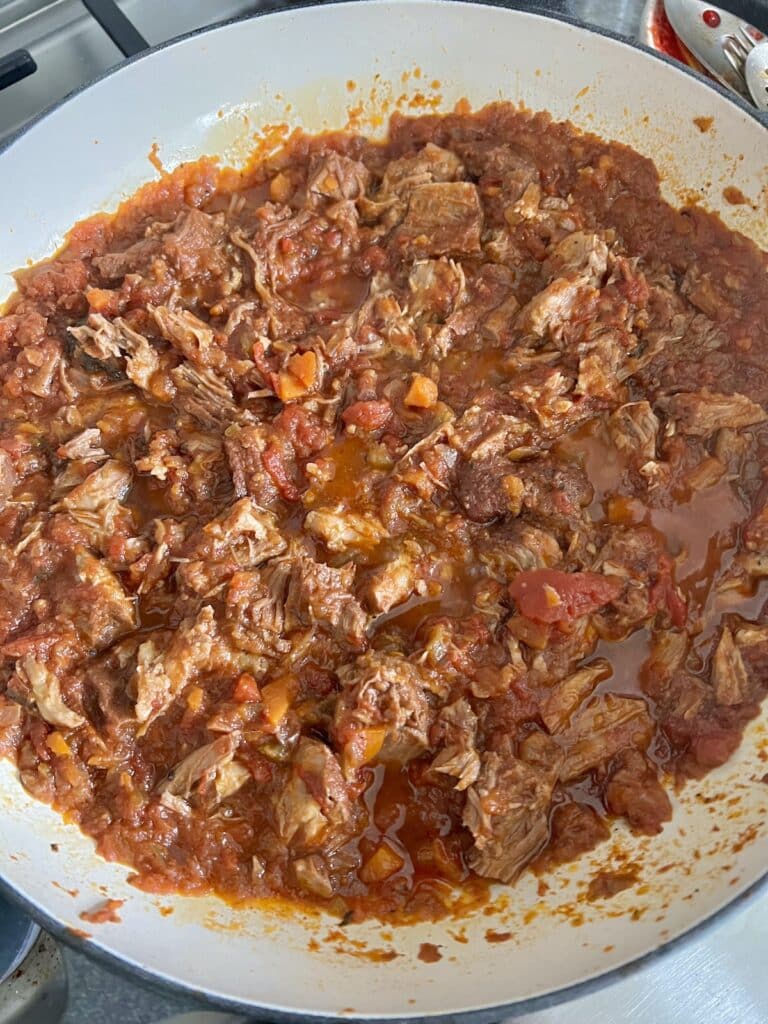
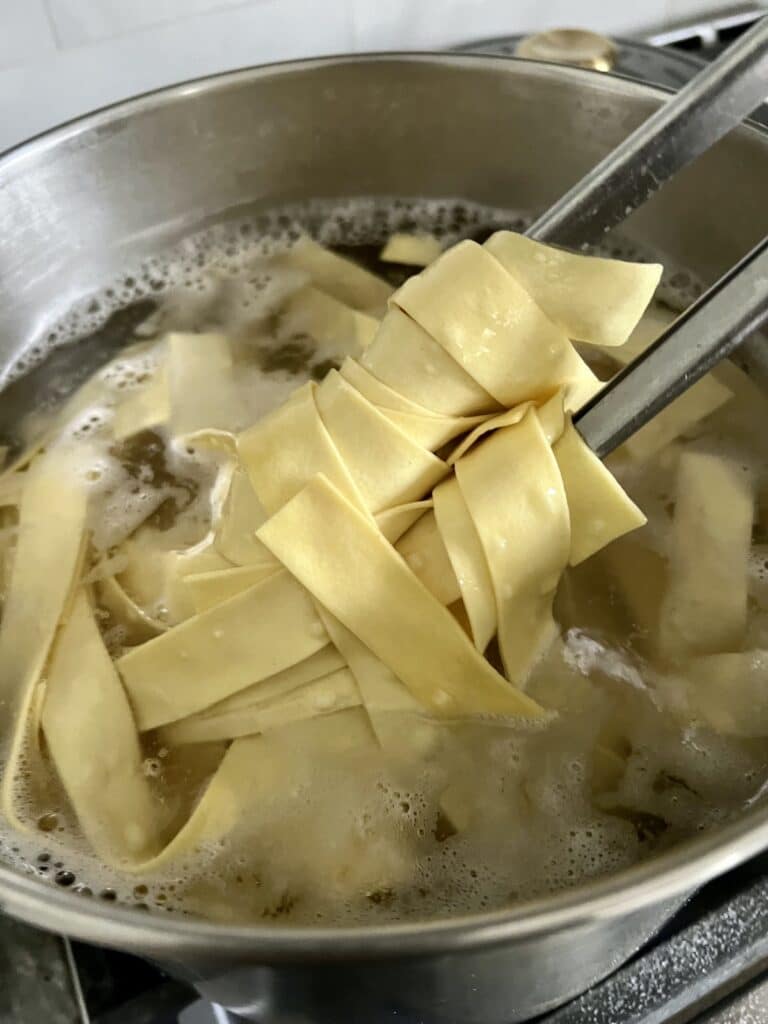
- Transfer the cooked pasta to the pan and allow the pasta to finish cooking in the wonderful flavors of the sauce. Add pasta water for additional moisture, about ½ cup at a time.
- PRO-TIP: You can also add some pasta water to the sauce before the pasta is added, if moisture is needed.
- Once the pasta is al dente, remove the pan from the heat. Then gently stir in the pecorino cheese, butter and herbs and drizzle with a good glug of extra virgin olive oil. Then, transfer to a serving platter and enjoy!
- PRO-TIP: The butter is “mounted” on the finished pasta at the end for additional richness and silkiness. This is optional and can be left out.
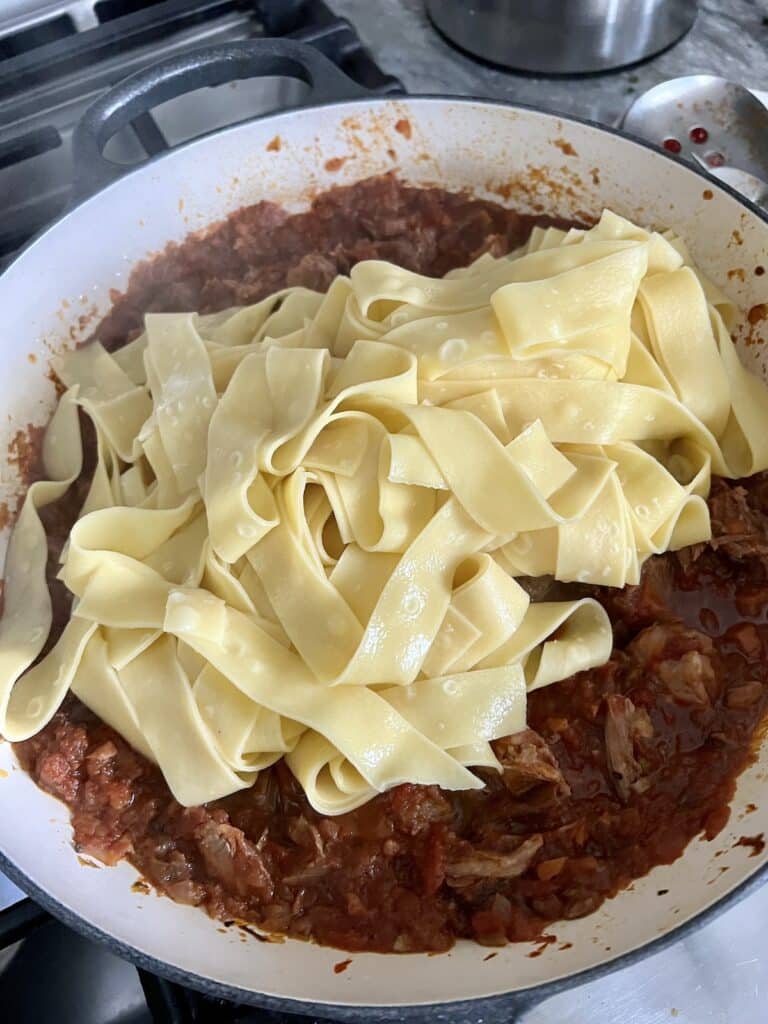

More Delicious Italian Recipes with Pork
Pork is such an important ingredient in Italian cooking. Here are some other recipes that feature it:

Frequently Asked Questions for this Pork Ragu Recipe
Yes. This recipe represents a basic ragu braising technique that can be used with any tough cut of meat, such as pork shoulder, beef short ribs or brisket. I often make this recipe with half country ribs and half boneless pork shoulder and it works out beautifully.
You can also use either pork back ribs or pork spare ribs in this dish–either will work well. The bone to meat ratio is higher with these cuts, though. So, you will need to increase the amount of meat used in the recipe.
This pork ragu/sauce can definitely be made in a slow cooker (without the pasta). Before adding the ingredients to the slow cooker, I suggest searing the pork pieces in a hot skillet. Searing locks in a ton of delicious flavor and creates the most delicious crust on the outside. Then, mix the pork and other ingredients together and add them to the slow cooker with the wine and tomatoes, cover and set on low for 6 to 7 hours or high for 3 to 4 hours or until the pork is fall-apart tender.
The ragu can be stored in an airtight container in the refrigerator for up to five days or freezer for up to three months.
I generally make this sauce 2 to 3 days in advance of when I’m serving it. The flavors develop well and any excess fat rises to the top and can be skimmed off before reheating.
When ready to serve, defrost the ragu in the refrigerator. Then, reheat it in a covered skillet, thinned with a little bit of water as needed to reach desired consistency.
Yes. Just sub in the same amount of beef or chicken broth for the wine.
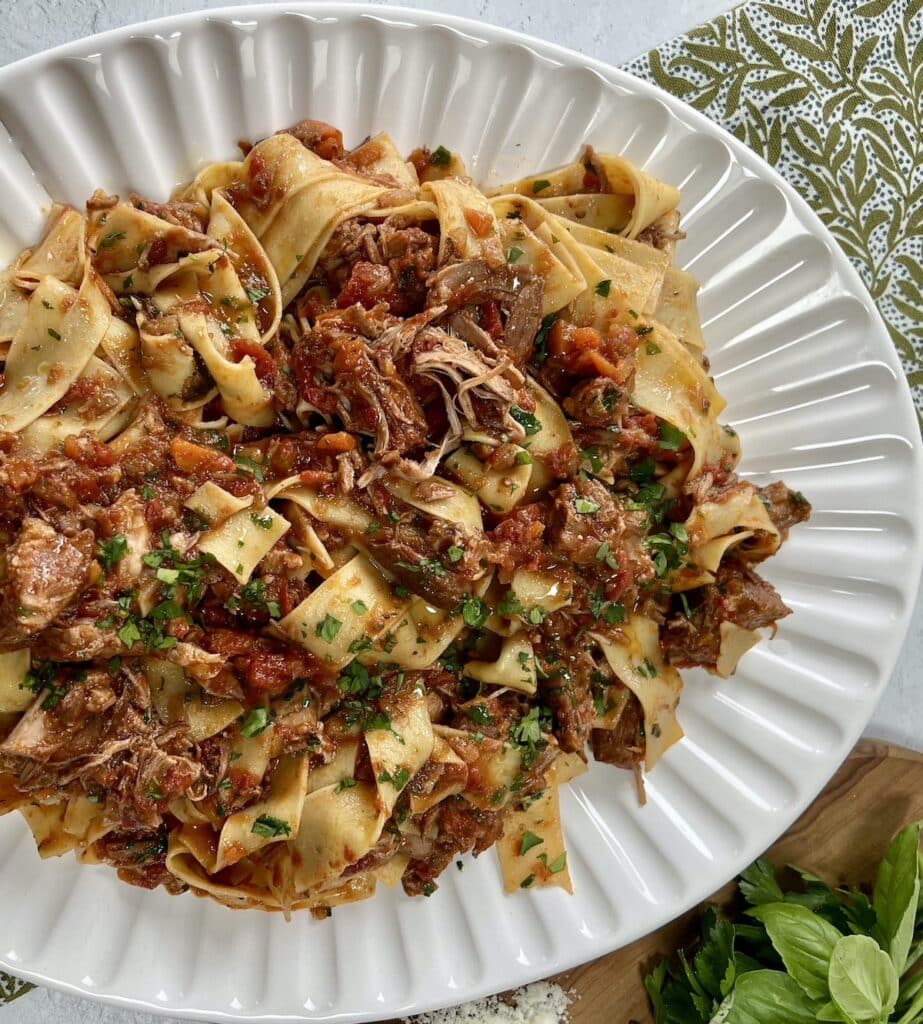
Serving Suggestions and Storage
I’ve paired this luscious, aromatic pork ragu recipe with wide, thick pappardelle noodles. And, there are many other strong pastas that would hold up well to this sauce, such as rigatoni, ziti, paccheri or gnocchi.
If you are a polenta fan, it is also very classic to serve this recipe over a big puddle of buttery, cheesy, creamy polenta.
And, depending on your mood, you could also top off this abbondanza with a dollop of fresh or herb-infused ricotta cheese. Mamma mia!
For sides, a simple green salad is perfect accompaniment and my go-to. It provides the perfect crispness and freshness to complement the rich ragu and pasta.
Don’t forget to serve this juice pork sauce with a little homemade chili oil for a final kick of heat!
Hold the ragu itself in an airtight container in the refrigerator for up to five days or in the freezer for up to three months. It freezes beautifully!
Leftover pork ragu with pasta can be stored in an airtight container in the refrigerator for up to 5 days. Reheat it, covered, in a small skillet over medium low heat with a little bit of water until heated through.

More Italian Recipes to Try
I hope that you are enjoying my Italian food blog Mangia With Michele and all of my Italian recipes!
If you’ve tried this Pork Ragu Recipe, let me know how it went in the comments below. I love hearing from you!
FOLLOW ME on FACEBOOK and INSTAGRAM to see more delicious food and what might be going on behind the scenes!
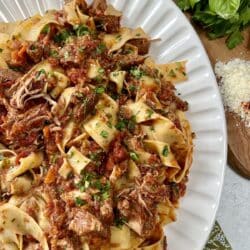
One Pot Pork Ragu Recipe (Braised Country Rib Sauce)
Equipment
Ingredients
For the Ragu:
- 3 pounds bone-in, pork country ribs, cut into individual ribs (about 6 ribs)
- Pinch salt and black pepper
- ¼ cup olive oil or other neutral oil for searing
- 1 large yellow onion, peeled and finely chopped or pulsed in food processor
- 3 small carrots peeled and finely chopped or pulsed in food processor
- 3 celery ribs, finely chopped or pulsed in food processor
- 6 cloves garlic, finely chopped or pulsed in food processor
- ⅓ cup chopped or hand-torn basil leaves
- ½ tsp crushed red pepper (optional)
- 1½ cups dry red wine such as cabernet sauvignon
- 2 (28-ounce) cans whole tmatoes, hand-crushed
- ½ can water
- 1 tsp salt
- 1 tsp dried oregano
- ½ tsp black pepper
For the Pasta:
- 1 pound pasta + salt for pasta water
- 3-4 cups pork ragu
- ¼ cup grated Pecorino Romano cheese
- 2 Tbsp butter at room temperature (optional)
- 2-3 Tbsp chopped basil and/or parsley
- Extra virgin olive oil
Instructions
- Gather and prep all ingredients as noted above. Separate the ribs into individual pieces if not already, and then pat them dry with a paper towel. Sprinkle all sides of the ribs with salt and black pepper.(Please see the section above in the blog post for Step-By-Step instructions with photos.)3 pounds bone-in, pork country ribs,, Pinch salt and black pepper
- The onions, carrots, celery and garlic can be processed/chopped together in a food processor for convenience. I suggest pulsing them a few times.1 large yellow onion,, 3 small carrots, 3 celery ribs,, 6 cloves garlic,
- Heat the oil in a large, heavy-bottomed pot, such as a Dutch oven, over medium heat. Carefully add as many ribs as will fit on the surface of the pot and sear them on multiple sides until brown, about 3 minutes per side. Do this in batches and do not overcrowd the pot. Remove the ribs to a plate once seared and set aside.¼ cup olive oil
- Add the onions, carrots, celery, garlic, crushed red pepper and fresh basil and stir to coat with the fat. Reduce the heat to medium-low and cook until the vegetables have mostly softened, about 6 to 8 minutes, stirring occasionally.1 large yellow onion,, 3 small carrots, 3 celery ribs,, ⅓ cup chopped or hand-torn basil leaves, ½ tsp crushed red pepper, 6 cloves garlic,
- Pour the wine in and deglaze the pan, scraping up all the brown bits.1½ cups dry red wine
- Add the tomatoes, ½ can water, salt, dried oregano and black pepper and stir until all ingredients are well-combined.2 (28-ounce) cans whole tmatoes,, ½ can water, 1 tsp salt, 1 tsp dried oregano, ½ tsp black pepper
- Carefully return the reserved ribs to the pot, along with any accumulated juices. Increase the heat to medium, cover and bring the mixture to a rolling simmer. Reduce the heat to maintain a low simmer and simmer, covered, for about 90 minutes. Then, change the lid to partially covered and continue cooking until the meat is fork tender and, literally, falling off the bone and a thick sauce has developed. This will take about 3 hours in total. Stir the mixture occasionally and test the texture of the pork every hour.
- (Alternatively, cook the pork in a 300°F covered with foil.)
- Once the pork has reached the desired consistency, turn off the heat and transfer the ribs to a dish. Let them cool briefly.
- Then, remove the meat from the bones and discard all the bones. Shred the pork with two forks (or your fingers) and return the meat to the pot, combining it with the sauce. Or, if you prefer, keep the meat/ribs whole (with or without the bones) to serve on the side.
- At this point, you can either use the ragu immediately store it in an airtight container in the refrigerator for up to five days or freezer for up to three months. (I generally make this sauce 2 to 3 days in advance of when I am serving it. The flavors develop well and any excess fat rises to the top and can be skimmed off before reheating.)
- When ready to serve, bring a large pot of water to a boil and reheat the ragu in a large skillet over medium-low heat.3-4 cups pork ragu
- Add salt, then the pasta, to the boiling water, stirring frequently. Cook the pasta for 2 minutes less than the package directions, or about 2 minutes before you think it is al dente. Be sure to reserve at least 1 cup of the starchy pasta water.1 pound pasta
- Transfer the cooked pasta to the pan, increase the heat to medium and toss well. Allow the pasta to finish cooking in the wonderful flavors of the sauce. Add pasta water for additional moisture, about ½ cup at a time. (You can also add some pasta water to the sauce before the pasta is added, if moisture is needed.)
- Once the pasta is al dente, remove the pan from the heat. Then gently stir in the pecorino cheese, butter and herbs and drizzle with a good glug of extra virgin olive oil.¼ cup grated Pecorino Romano cheese, 2 Tbsp butter at room temperature, 2-3 Tbsp chopped basil and/or parsley, Extra virgin olive oil
- Transfer to a serving platter, sprinkle with a bit more grated cheese and serve immediately. Buon Appetito!
Notes
- The above recipe makes approximately 10 cups ragu with shredded meat included, which is enough to dress 2 to 3 pounds pasta.
- If you are only making one pound pasta, I suggest freezing the remaining ragu in an airtight container for up to three months. This way, you can have a delicious pork ragu when desired any night of the week! Defrost the ragu in the refrigerator when ready to enjoy. Then, reheat it in a covered skillet, thinned with a little bit of water as needed to reach desired consistency.
- You can halve the above recipe for a smaller yield.
- As an alternative to the above recipe, you can use half pork ribs and half boneless pork shoulder. Cut the pork shoulder down into 3 to 4”-sized pieces before searing and braising, then proceed with the rest of the recipe.
- This pork ragu works well with all sorts of short and long shapes of pasta. Some of my other favorites to use in this recipe are rigatoni, gnocchi, ziti, penne rigate and paccheri.
- I love shredding the pork and stirring it into the sauce. But, sometimes, I will leave the pieces of meat whole and serve them on the side, using just the rich sauce to toss with the pasta.
- The butter is “mounted” on the finished pasta at the end for additional richness and silkiness. This is optional and can be left out.

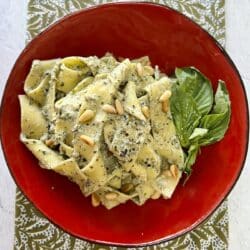
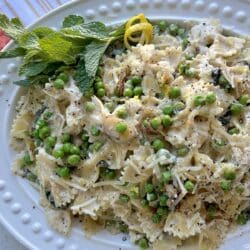

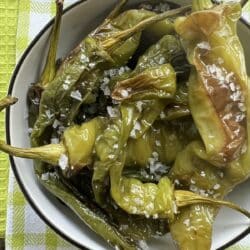
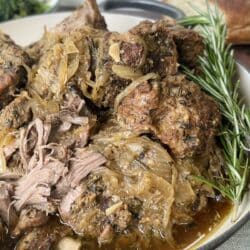
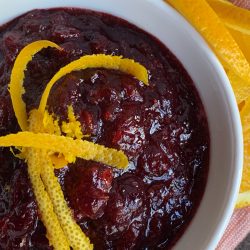

FABULOUS RECIPE! EASY AND HUBBY LOVED IT. I LEFT A FEW RIBS WHOLE AND SHREDDED THE REST, IT IS ON MY LIST OF DINNERS TO MAKE MORE FREQUENTLY FOR SURE!
i have some CS ribs in the freezer, can’t wait to try this!
Seriously-the best recipe ever! Brings back lots of memories.